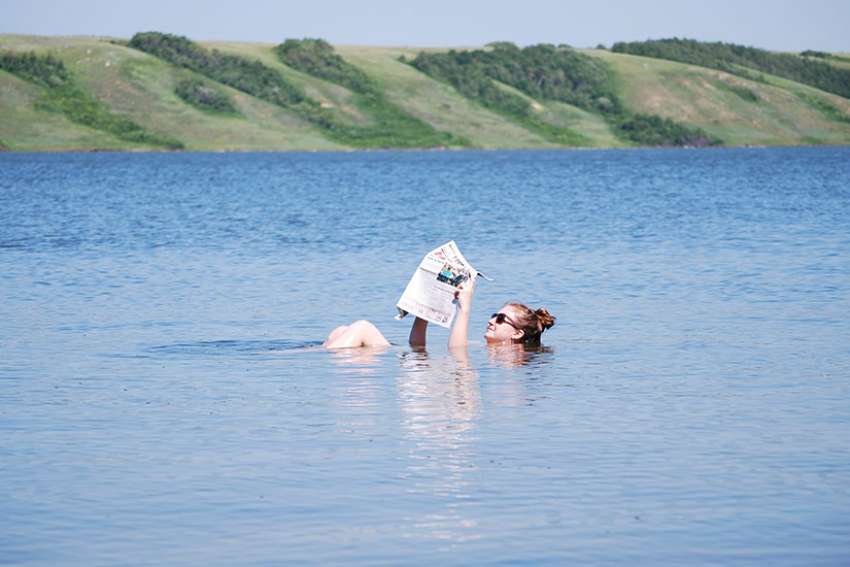Much less well-known, but with a healing touch of its own, is Little Manitou Lake, landlocked between Saskatoon and Regina on the Canadian Prairies. Locally, it is proudly called the Dead Sea of Canada.
Little Manitou Lake is unlike any other in North America. Carved out by glaciers, the lake’s bed has springs that release magnesium, potassium, silica, iron oxide, calcium and sulphate into the water, providing the highest mineral content in any North American lake. There is so much salt in the water — remember, we’re talking about Saskatchewan, thousands of kilometres from any ocean — that like the Dead Sea, swimmers can float without effort and there is almost zero possibility of drowning.
“You can’t drown,” said Fr. Richard Meidl, pastor at St. Ann’s parish in Watrous, a five-minute drive from the shores of the lake.
Meidl is the pastor of St. Ann’s and two mission parishes — Young, at the lake’s west end, and Imperial to the south — in an area known as the Lake Manitou Pastoral Region in the Archdiocese of Saskatoon. He’s been in the area for two years, but knew of the lake and its healing powers through a fellow Benedictine from St. Peter’s Abbey in Muenster, north of Saskatoon, who was raised in the area.
The legend of the healing waters of Little Manitou Lake goes back to the original Indigenous inhabitants of the area in the pre-reserve days when smallpox almost wiped out large tribes of the Cree nation. As told by Dan Kennedy of the Assiniboine nation in Prairie Reflections, winter-bound Cree in what is now central Saskatchewan were ravaged by the disease, and when spring broke survivors migrated towards the Saskatchewan River. Three braves took sick en route and when the tribe camped at the lake, the three were too ill to carry on. Shelter was built for the men and the rest of the tribe continued on its journey, never expecting to see these men alive again.
One of the fever-crazed men crawled to the shore of the lake, drank the water and bathed in it. Still too weak to make his way back to the others, he lay there overnight, waking the next morning free of fever. He gathered his sick companions, took them to the lake’s waters and they too were healed. Their fellow tribesmen were convinced they were seeing ghosts when the braves caught up to them days later.
It’s only one of the many fantastic stories locals share of the lake’s healing ways, including one of a gangrene sufferer who sat in the water for 12 hours a day for more than a week. Little Manitou Lake’s waters are credited with saving the man from having a limb amputated.
The lake’s healing ways have been attracting people to the area ever since. At St. Pat’s, Meidl sees higher numbers in his parish. One recent weekend, Meidl welcomed 10 to 12 worshippers at St. Ann’s — out of the regular 100 congregants he sees on Sundays — who were drawn by Little Manitou’s waters.
“It was because of the lake, the notoriety of it, that’s why they were here,” he said.
The parish also draws people who have seasonal residences and others who own businesses related to the lake.
Meidl has reconnected with former parishioners from across the province who have come for the “Dead Sea” experience, some of the many from across Canada’s four western provinces Meidl has encountered. He’s met people from as far away as Germany.
The area has capitalized in the past on the lake’s notoriety. During the 1930s, it was almost on par with Banff in the Canadian Rockies for American and European visitors. It was even considered the “Carlsbad of Canada” for its similarities to the Czech spa city of Carlsbad. But vacation patterns changed with railroad and highway infrastructure changes, and it took several decades before the area began to re-capitalize on the lake’s similarities to the Dead Sea. In 2012, it was chosen one of the top 12 places to travel in Canada by Vacay.ca. Manitou Springs Resort and Mineral Spa is the primary tourist attraction.
Meidl himself has indulged in the local pleasures, but not the lake.
“I never did go into the lake because I don’t swim, so I prefer the spa,” he laughed. “Especially as I’m aging and getting more creaky as time goes on.”
(Conlon is a writer in Regina.)


